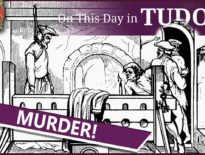On this day in Tudor history, 5th December 1560, King Francis II of France, died at the age of just 15. Francis was King Consort of Scotland, as the husband of Mary, Queen of Scots, and his father had also proclaimed him and Mary as King and Queen of England back in 1558!
He was taken ill in mid-November with what appears to have been an ear infection, and it led to him dying on this day in history. His death led to Mary, Queen of Scots, returning to her homeland of Scotland, a country she hadn't seen for 13 years.
Find out more about Francis II of France, his marriage to Mary, Queen of Scots, his death and what happened next, in today's talk.
Also on this day in Tudor history, 5th December 1556, Anne de Vere was born, She was the daughter of William Cecil, 1st Baron Burghley, and his second wife, Mildred Cooke. Anne only lived until she was 31 years old, but in her short life she managed to impress scholars, have five children, and have a rather eventful and unhappy marriage with Edward de Vere, Earl of Oxford, who didn't treat her at all well and even refused to recognise their first daughter as his own, at one point. If only she had married Philip Sidney instead! Find out more about Anne in last year’s video:
Also on this day in history:
- 1558 – Death of Gabriel Dunne (Donne), Abbot of Buckfast and 'keeper of the spiritualities', in the diocese of London. He was buried at St Paul's, before the high altar.
- 1562 – Death of Sir Humphrey Browne, judge. He was buried at St Martin Orgar. London. Browne had served Henry VIII as a Sergeant-at-Law, but lost the office when he was imprisoned for hunting in Waltham Forest and for, allegedly, advising criminals on how to avoid having their possessions forfeited.
- 1593 – Death of Sir Rowland Hayward (Heyward), merchant adventurer, President of St Bartholomew's Hospital and member of Parliament, in London. He was buried at St Alfege, London Wall.
Transcript:
On this day in Tudor history, 5th December 1560, King Francis II of France and King Consort of Scotland died at the age of just 15. He was laid to rest at the Cathedral Basilica of Saint-Denis on 23rd December.
Why am I talking about the death of a French king when this is supposed to be a channel on Tudor history?
Well, because Francis was the husband of Mary, Queen of Scots, and because after the death of Mary I in 1558 and the accession of Elizabeth I, Francis’s father, Henry II of France, proclaimed Francis and Mary King and Queen of England and quartered the arms of England with those of his son and daughter-in-law, challenging Elizabeth I. And, of course, following Francis’s death, Mary returned to Scotland and it wasn’t long before Mary and those who supported her claim were causing trouble for Elizabeth I and her government.
Let me tell you a bit more about Francis II…
• Francis was born on 19th January 1544 and was the son of King Henry II of France and his wife, Catherine de’ Medici.
• In 1548, when Francis was just four years old, his father came to an agreement with Scotland on the betrothal between Francis and five-year-old Mary, Queen of Scots. It was agreed that Mary would travel to France to be brought up with Francis and his siblings at the French court. She landed at Roscoff on 13th August 1548.
• Just under 10 years later, on 24th April 1558, fourteen-year-old Francis married fifteen-year-old Mary in a lavish ceremony at Notre Dame Cathedral in Paris. Pierre de Bourdeille, seigneur de Brantôme, wrote of how Francis was “madly in love” with Mary, who was “more beauteous than a goddess from the skies”, and that they lived “together in great love and pleasant concord”.
• On 30th June 1559, Henry VII was injured during a tournament. He was jousting against Gabriel Montgomery, Captain of his Scots Guard when a splinter from Montgomery’s shattered lance pierced his eye and entered his brain. His physician, Ambroise Paré, did all he could to save the king but Henry died on 10th July 1559, passing the throne to Francis.
• Francis was crowned king on 21st September 1559 at Rheims Cathedral by Mary’s uncle, Charles, Cardinal of Lorraine and Archbishop of Rheims. It was traditional for queen consorts to be crowned and anointed in a separate ceremony, so although Mary was present, she was just a spectator at this ceremony.
• Although Mary thought she was pregnant in the summer of 1560, she sadly wasn’t, and the royal couple didn’t have any children before Francis’s death.
• Francis started suffering from dizziness and tinnitus in mid-November 1560 and on 16th November he collapsed. He then began suffering severe pains in his ear, and by late November, he was experiencing seizures. In his last days, fluid was leaking from his ears, nose and mouth, and he became delirious. He died late in the evening of 5th December 1560 and was succeeded as King of France by his brother, Charles, who became Charles IX, with his mother, Catherine de’ Medici, acting as regent.
• The widowed Mary was not wanted or needed by the Regent Catherine and so planned her return to Scotland, having been absent from her kingdom for thirteen years. She set sail from the port of Calais on 14th August 1561, and as her galley left the harbour, a ship collided with another vessel and sank, drowning all of its crew. Mary worried that this was a bad omen. She broke down and burst into tears as the French coast disappeared from view, saying “Adieu France. It's all over now. Adieu France. I think I'll never see your shores again.” She landed at Leith on 19th August.
• Mary went on to marry Henry Stuart, Lord Darnley, in July 1565, but lost the throne of Scotland when she was forced to abdicate in July 1567 following Darnley’s murder and her subsequent marriage to the Earl of Bothwell, a man implicated in Darnley’s murder. Her son by Darnley, one-year-old James became King James VI of Scotland. Mary, of course, was executed as a traitor in 1587 after being implicated in the Babington Plot against Queen Elizabeth I.



Leave a Reply